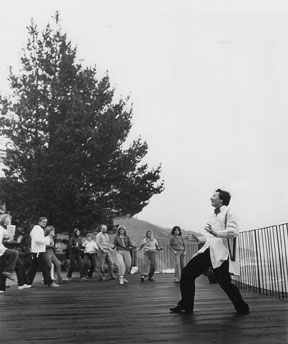|
||
      |
Peer Review ::
Spiritual and religious
Scholar Jeffrey Kripal examines the human potential of the Esalen Institute.
As a teenager in late-1970s Nebraska, Jeffrey Kripal, AM’87, PhD’93, “missed the counterculture both temporally and spatially,” he says. Then 20 years later he got a phone call that eventually led to his recent book on a counterculture emblem, the Esalen Institute—a Big Sur, California, center where residents and visitors study and practice meditation, massage, yoga, psychology, spirituality, music, art, and more.

Tai chi master Chungliang Al Huang performs at Esalen in the late 1970s.
The phone call was from Esalen cofounder Michael Murphy, who had read Kripal’s book Kali’s Child (U of C Press, 1998), about the 19th-century Hindu saint Ramakrishna. Murphy “somehow tracked me down, called me around midnight from California, and invited me out there,” says Kripal, the J. Newton Rayzor professor and chair of religious studies at Rice University. It was his first visit. “I gave a talk at a symposium,” he says, “and kept getting invited back.” His growing interest in the center inspired him to write a history, Esalen: America and the Religion of No Religion (U of C Press, 2007).
The fit was natural. Kripal has what he calls a “tortured” relationship with his inherited Catholicism and moved toward Hinduism while studying at the Divinity School. He’s written books on “the comparative erotics of mystical literature,” or, as he explains, “how sexuality is used, repressed, and sublimated in religious literature, and how that plays into...things like celibacy.” Esalen, meanwhile, is famous for both its “translation of Asian religions in American culture” and for its sensuality—especially the hot springs overlooking the ocean that feature nude bathing.
At the institute, Kripal says, activities such as nude bathing are not simply about sex. “The sensuality at Esalen is a kind of sacred ritual space. It’s an open and respectful sensuality,” he says. The Esalen culture is “very aware that religious experience and gender and sexuality are all related.”
The main aspect of that culture is the human-potential movement that Murphy and writer George Leonard advocate. Through “peak experiences, actualization, meditation,” and other exercises, Kripal says, Esalen residents “practice these techniques to explore human potential” and become “self-actualized human beings.” The practice involves integrating science and religion, east and west, and body and spirit.
Those ideas have remained paramount since 1962, when Murphy and fellow Stanford graduate Richard Price founded Esalen, named for the American Indian tribe that once lived along the institute’s Northern California coastline. Already known as a bohemian enclave, where banned-book author Henry Miller lived, Big Sur became home to Esalen and its ethos of “religion of no religion,” a phrase Murphy and Price appropriated from their dynamic comparative-religion professor, Frederic Spiegelberg.
A contemporary translation of “religion of no religion,” says Kripal, is when people say they’re “spiritual but not religious.” While Esalen embraces many religions, its residents believe that “no one captures the flag, and all religious language is symbolic.” The philosophy allows a person to embrace both Buddhism and Christianity, for example, without being bound to a specific text.
Although the institute predated the counterculture, the San Francisco–based movement “swamped Esalen,” Kripal says. Esalen’s founding ideas “linked up” with those of the counterculture—“the integration of east and west, body and spirit”—and that connection thrust the institute into public consciousness. George Harrison and Ravi Shankar spent time there, and Joan Baez and Hunter S. Thompson lived on the grounds.
“When people hear mention of Esalen now,” Kripal writes in the April 13 Chronicle of Higher Education Review “they often dismiss it as ‘New Agey’—lacking in substance and rigor at best, flaky and irrelevant at worst.” But for Kripal the institute “holds a legitimate place in America’s religious history and spiritual landscape,” and, from its academic roots, has intellectual heft.
Kripal’s Esalen research led him to his current project, a book on comic books as occult literature. Murphy, he says, espouses the idea that the entire universe is in God, and evolution is the way humans “come into super consciousness, the driving force of divinity in the world.” The philosophy stems from the Indian philosopher Sri Aurobindo and British thinker Frederic W. H. Myers. And, Kripal says, “it seemed to bear an uncanny similarity to X-Men.”